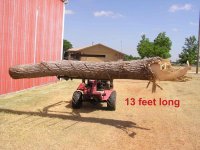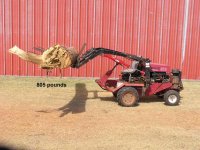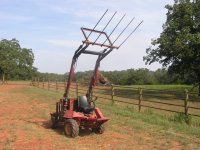Hello All,
Here is the bottom line...the sideways rollover angle for my Kioti DK40 Hydro FWD, with FEL positioned with an empty bucket parallel to the ground, and Tartar 6 bush hog - and in all likelihood most similarly equipped stock utility class tractors - is above 40 degrees. Add 4 spacers on each rear wheel and you'll add, as expected, a measurable margin of safety to the rollover angle in either direction. In this post I'll show the math so you can play around with your tractor's dimensions. This was a real confidence-builder for me to see these predicted rollover angles. So if you want to have a full understanding, or join in a discussion, or check my math, please read on.
I recently bought my 4 inch rear wheel spacers from Motorsport-Tech in Reno, NV,, a sponsor of this forum, and I am extremely pleased. Lenny, the owner, was great to work with throughout - and very concerned I would be happy with my product. I have no doubt that if your spacers arrived and didn't fit, or were damaged, Motorsport-Tech would build ones that met your needs at their expense. I had them installed by my dealer two weeks ago during the 50 hour tractor service - they fit perfectly and came with quality hardware. Before and after photos below. I had them anodized black by Lenny for an additional $25 each to better keep the aircraft grade aluminum from corroding where bare aluminum might touch any bare dissimilar metal - bolts, nuts, washers, axle ends and rims. The anodizing, if not scratched, will prevent corrosion. I added another layer of protection by spray painting them with Kioti Charcoal Gray paint, which was an exact color match to the anodizing. Painting them only cost 15 bucks for the can of spray paint so why not? My anti-corrosion obsessed brain sleeps well knowing they should look new in 30 years when I'm 87 *grin*.
Driving the tractor with spacers felt entirely normal. I felt more comfortable seeing the wider rear wheelbase from the driver's seat. We all can take one look at a wider wheel base and imagine, all other things being equal, that it will take more jacking up of one side on level ground to tip it over. But I wanted to know - how much extra stability do 4 spacers buy us? 6 degrees? 10 degrees? What's your guess? Mine was 6-7 degrees, but that wasn't correct.
I consulted a physics major who knew how to do the math to figure out the roll angle at which a tractor will tip over. Warning! Disclaimer! Don't shoot me! I offer this exercise believing it is correct, but it is for informational purposes only. I bear no responsibility for any accidents anyone might have if they decide to drive on steeper side hills because of what this static, level ground, and admittedly incomplete formula predicts their rollover angle might be. It's incomplete because there are a lot of constantly changing rollover variables in any moving tractor. I'll list some here - and mention what we need to realize about how they might affect a rollover. The thread by Kentuckytractorboy and others have great comments, but I'll still recap here.
The incline of any side hill is what we're basically talking about - but the hillside's angular degree is rarely constant as we drive across it. Uneven terrain can quickly increase the effective hillside's angle. Tractor speed when a tire hits a bump or depression needs to be slow to avoid any catapulting effect that would temporarily increase effective hillside angle. Speed in a turn where centripetal force is exerted can significantly affect a rollover. Differential braking is dangerous at speed since it creates a turning moment. Centripetal force always increases the likelihood of a rollover opposite the direction of turn, however there is one situation where a turn might prevent a rollover. If you fear a side hill rollover is imminent, or beginning, a quick turn downslope and the resultant centripetal force you generate may offset gravity in time. A turn downslope will also effectively decrease the angle of the side hill relative to your tractor's horizontal CG. So slow is always good and fast is almost always bad. The equation doesn't consider all these dynamic factors. It doesn't consider any coefficient of friction for the surface being driven on either - it assumes the tractor tires will not slide sideways. A static computation should be accurate enough for us to make intelligent operating decisions as long as we think about these variables.
Steps we can take to increase rollover angle under all operating conditions are to lower vertical CG and/or widen the wheelbase. If the tires are loaded with fluid the CG will be lowered. How heavy and how high the rear implement is carried (if installed) will affect vertical CG (and horizontal CG if weight is out to one side). How high the FEL is off the ground and its load is a very large variable. Positioned lower and carrying lighter loads is very important. The weight and height of the driver will have some effect since the driver sits above the normal vertical CG. Even if the fuel tank is full or empty will have a small effect - full raises the CG slightly.
Unfortunately I don't know my tractor's exact CG in terms of its vertical height off the ground - and as mentioned above it does dynamically vary when the rear implement and the FEL are in use. For purposes of showing how stable our tractors are stock, and the difference with spacers, we can explore a range of likely vertical CG's.
I do know my before spacer installation horizontal distance, with the widest stock placement of the tires in relation to the rim which the manual allows that I had the dealer perform at delivery, and I know the distance of that same tire configuration after rear wheel spacer installation. To determine your horizontal distance from an assumed middle of the tractor CG measure from about one inch outside your tractor's rear wheel tread midpoint on one side to the same one inch outside your tractor's other wheel midpoint and divide by two. I chose this measurement point instead of the outside edge of my rear tires because my Industrial tires are flat only in the middle couple of inches and they round down towards the outside of the tire. Our tires will also flex to some degree with thousands of pounds of force being increasingly exerted on the edge of the sidewalls as the side hill angle increases. In fact, if you have too underinflated tires the tires may "t麹uck under", or roll off the rim, and lose more pressure, all of which is a bad thing. Your wheelbase quickly shortens and your rollover angle correspondently decreases - over you may go. So my measurement point is a conservative, safer measurement point compared to the very outside of the tires and yields a slightly lower predicted rollover angle. Here are a number of static rollover angles based on a range of vertical height CG's.
Rhino's Kioti DK40 Rollover Angle Calculations
Vertical CG Horizontal CG Predicted Rollover Angle Diff. with 4" Spacers
25 inches 32 inches 52.00 degrees
25 inches 36 inches 57.20 degrees 5.20 degrees
31 inches 32 inches 45.90 degrees
31 inches 36 inches 49.25 degrees 3.35 degrees
33 inches 32 inches 44.15 degrees
33 inches 36 inches 47.50 degrees 3.35 degrees
36 inches 32 inches 41.65 degrees
36 inches 36 inches 45.00 degrees 3.35 degrees
40 inches 32 inches 38.70 degrees
40 inches 36 inches 41.98 degrees 3.28 degrees
46 inches 32 inches 34.83 degrees
46 inches 36 inches 38.00 degrees 3.18 degrees
55 inches 32 inches 30.19 degrees
55 inches 36 inches 33.20 degrees 3.01 degrees
and, lastly, a really high, heavy FEL load best vertical CG guess...
72 inches 32 inches 24.00 degrees
72 inches 36 inches 26.50 degrees 2.50 degrees
Here is how you calculate a static rollover angle. You'll need a calculator capable of performing "t麹an" functions. I'll do it for one of the above examples. Just plug in your own values.
Divide your estimated (or known if you know it) vertical CG height by the horizontal distance from the center of the tractor to about one inch outside your rear tractor tire's centerline. Measure from tire to tire and divide by 2 to get this horizontal distance. 33 vertical CG divided by 36 horizontal distance equals .9167. Write this number down.
Now you have to do some trial and error calculations to find a corresponding tangential angle. If the above number is less than 1 clear your calculator and pIck an angle less than 45, then hit "tan". A decimal will be shown. If it is greater than 1 pick an angle greater than 45 and you'll get 1 plus a decimal value. The goal is to close in on the same number as .9167 - in my example - or whatever you got as a value. A higher angular guess will yield a higher number. So 44 degrees and hitting t麹an yields .9657. I need a lower number so I'll try 43 = .9325 - still not there. 42 is .9004 - too low. 42.5 is .9163 - close enough!
Then subtract 42.5 from 90 degrees. 90 - 42.5 equals 47.50. This is my predicted rollover angle for that vertical height CG and the horizontal distance with spacers. If you are like me you'll need to do these calculations a few times to feel you understand it. Try a few of my examples above and if you get the same predicted rollover angles you're on track. Then go measure your tractor's wheelbase and try some likely vertical CG's of your own.
Conclusions
The good news is that with the stock widest wheelbase tire/rim setup my Kioti predicts pretty high side hill stability at the most likely vertical CG's with which I would be bush hogging. My FEL arms are roughly parallel to the ground and the bottom of my empty bucket is raised one to two feet off the ground. My best guess is that in this bush hogging configuration, full fuel and my 215 pounds in the seat the vertical CG of my tractor is between 33 and 36 inches. Without the spacers the predicted rollover range would be between 41.65 and 44.15 degrees and with the spacers a predicted rollover angle of between 45 and 47.5 degrees.
Even knowing these values I know my comfort zone on side hills will never get above 25 degrees. But it's pretty comforting to know 25 degrees shouldn't ever roll me over - or even a momentary screw up where one side of the tractor comes up 10 degrees or the other goes down 10 degrees.
Hope this was useful. Safety first.
Rhino










